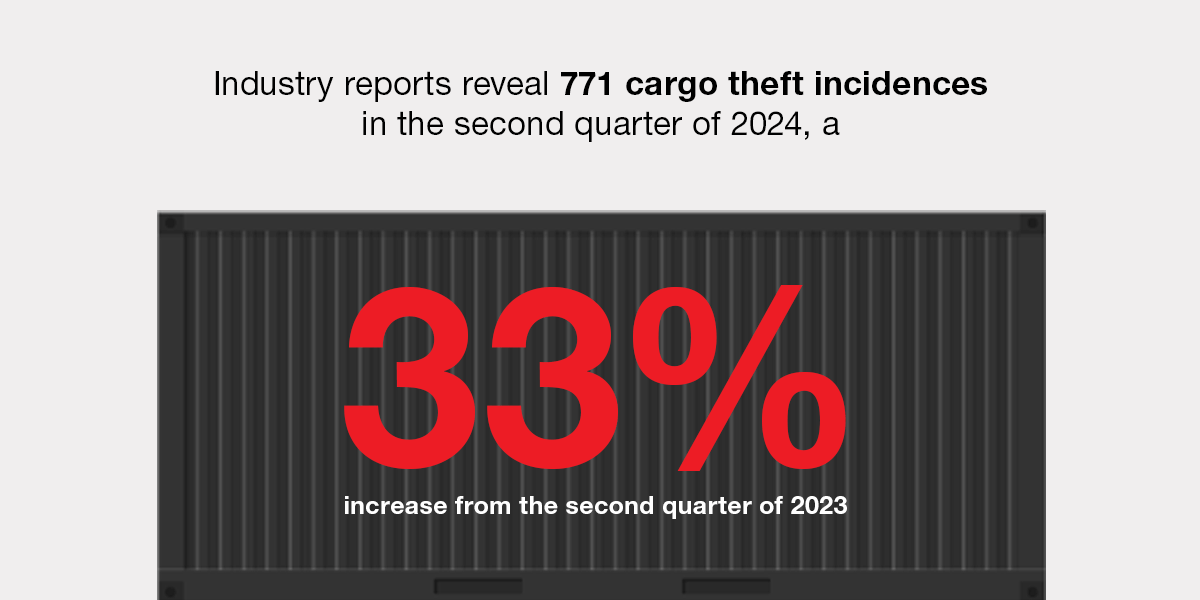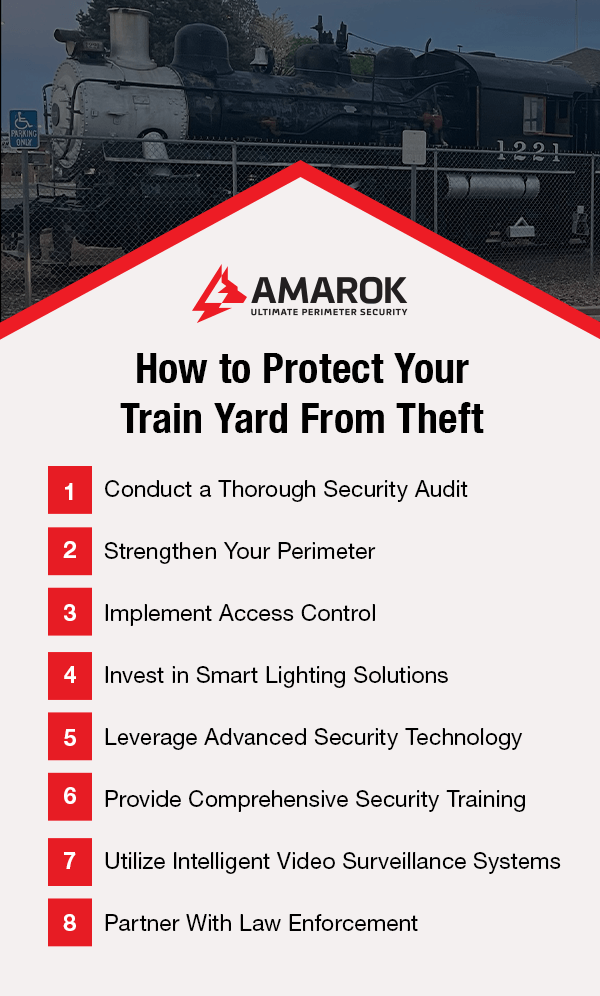Train yards are a tempting target for criminals who want a quick profit. The high value and volume of cargo transported by rail facilities make them attractive targets for criminals, and freight train theft has sharply increased in recent years. In April 2024, authorities in San Bernardino arrested multiple people trying to commit freight train theft at the Cajon Pass. A few months later, in October 2024, four people were arrested after crowds of thieves stole from a freight train on Chicago’s West Side.
Persistent thieves employ various methods to steal from train yards, ranging from simple break-ins to elaborate schemes involving inside information. As train yard theft continues to rise, protecting these vital transportation hubs requires a proactive, multi-layer approach to security that addresses immediate threats and long-term vulnerabilities.
Common Types of Theft in a Train Yard
Train yards present uniquely challenging security scenarios due to their vast size, multiple access points, and high concentration of valuable assets. Thieves use many tactics for cargo theft in these settings, including:
- Breaking and entering: The simplest train yard theft involves breaking into rail cars and containers. Thieves may cut locks, pry open doors, or use power tools to gain access. Once inside, they can quickly transfer valuable goods to waiting vehicles and flee the scene before security personnel respond.
- Fraudulent pickups: More sophisticated criminals may attempt to steal entire containers or trailer loads by impersonating legitimate truck drivers. Using forged paperwork and counterfeit IDs, they’ll arrive at the train yard to pick up a shipment that does not belong to them. If the ruse is successful, they can drive off with hundreds of thousands of stolen cargo.
- Insider jobs: Perhaps the most challenging type of train yard theft to prevent is one carried out with the assistance of a company’s employees. Workers with inside knowledge of rail operations can identify valuable shipments and provide access to outside accomplices. In some cases, they may even take an active role in the theft, using their credentials to bypass security measures.
The most common types of train yard theft include:
Cargo Container Theft
Intermodal container theft is the most financially damaging threat to rail yards. Industry reports reveal 771 cargo theft incidences in the second quarter of 2024, a 33% increase from the second quarter of 2023. Organized criminal groups target high-value shipments, often conducting surveillance to identify optimal theft opportunities. These operations involve multiple people who monitor yard operations, seeking vulnerabilities in security protocols or timing their actions during shift changes. Cargo container theft leads to financial losses, higher insurance premiums, operational disruptions, and a loss of trust from customers.

Metal and Infrastructure Theft
Criminals target copper wire, railroad ties, and other metal components that command high prices at scrap yards. Infrastructure theft causes material costs, disrupts operations, and creates safety hazards. It can also compromise operational safety across multiple routes.
Equipment and Tool Theft
Maintenance equipment, specialized tools, and service vehicles represent substantial investments for railway operators. Criminals target these assets for immediate resale and to facilitate future thefts. Losing essential maintenance equipment can paralyze critical repair operations, leading to costly delays and potential safety issues. Criminals often target specific high-value tools and equipment, suggesting inside knowledge of operations and inventory.
Fuel Theft
Fuel theft is a persistent threat to rail operations due to volatile fuel prices. Sophisticated criminals employ various methods, from siphoning to elaborate schemes involving modified trucks and storage systems. These incidents often result in property damage and high fuel replacement costs.
How to Protect Your Train Yard From Theft

Combating diverse train yard theft tactics seems daunting, but concrete steps can reduce the risk. Implementing multiple layers of deterrence is critical to protecting train yards from theft.
1. Conduct a Thorough Security Audit
A thorough security audit is vital to preventing train yard theft. Assessing your vulnerabilities and identifying improvement areas enables you to develop a targeted plan to strengthen your facility’s defenses, reducing the theft risk.
Review existing security measures, policies, and procedures. Examine your facility’s defenses to identify gaps, weaknesses, or inconsistencies that criminals could exploit to steal cargo or equipment. Walk through your train yard, checking for potential vulnerabilities such as:
- Poorly lit or obscured areas that could provide cover for intruders
- Inadequate fencing or barriers that could be easily breached
- Unsecured entry points or lack of Access Control measures
- Insufficient surveillance coverage or blind spots in camera placements
Test your existing security systems to ensure they are functioning as intended. You should also identify vulnerabilities in your digital infrastructure by reviewing the following:
- Network architecture and security controls
- Data encryption and protection measures
- Access management and authentication protocols
- Employee cybersecurity awareness and training programs
Partnering with a professional for your security audit is often wise, as experienced security personnel will know about your area’s threat landscape as well as the most current criminal tactics. They will also know how to use the security audit findings to develop a prioritized action plan for addressing vulnerabilities.
2. Strengthen Your Perimeter
A robust perimeter is your first line of defense against train yard theft. One of the most effective ways to keep criminals at bay is to install a high-security electric fence around your train yard. The warning signs advertising the presence of an electric fence are often enough to deter most criminals. For the more determined criminal, electric fences deliver a safe but memorable shock to would-be intruders, preventing them from breaking in.
When selecting an electric fence for your facility, look for an advanced system that features:
- Solar-powered operation to ensure continuous protection even during power outages
- Zoned monitoring for precise threat location identification
- Safe but ample voltage to provide a robust physical deterrent
- Integration with monitoring services for 24/7 surveillance and response
- Remote monitoring and control through mobile applications
- High-visibility warning signs in multiple languages
When installing an electric fence, consider proper positioning relative to existing fencing, compliance with local regulations, and strategic placement of warning signage. The most effective implementations create a clear security zone while maintaining operational access for authorized personnel. Investing in electric fencing pays off within the first year through reduced losses, lower insurance premiums, and decreased security staffing requirements.
3. Implement Access Control
Access Control systems are crucial to preventing train yard theft while maintaining efficient operations. An Access Control system tracks personnel and vehicles, reducing internal theft. Essential components of an effective Access Control system include:
- Multifactor authentication protocols, including RFID cards, key fobs, and PIN codes
- Biometric verification options
- Vehicle gate control integration
- Visitor management systems with temporary visitor passes
- Time-restricted access permissions
- Emergency lockdown capabilities
Integrating these components into existing security infrastructure fortifies your train yard against theft. Ensure you incorporate backup power systems for continuous operation, clear protocols for contractor access, and emergency override procedures.
It’s also vital to control movement within the train yard. Implementing a zoned security approach, in which employees can only enter the areas required for their job duties, can greatly reduce the risk of insider train yard theft.
4. Invest in Smart Lighting Solutions
Well-designed lighting is one of the most effective tools for deterring crime in your train yard. Criminals prefer to operate under the cover of darkness, so illuminating your entire facility can make it a much less appealing target.
When planning your lighting strategy, aim for bright coverage that eliminates shadows and blind spots. Pay attention to your perimeter fencing, storage areas, and potential hiding spots. LED light fixtures are durable, energy-efficient, and provide powerful illumination. Many models feature motion sensors and can integrate seamlessly with your security system, providing an extra layer of automated protection.
Use alarm-based lighting for better train yard theft deterrence. These advanced setups use sensors to detect potential intruders and instantly flood the area with bright light while triggering a security alert. The sudden illumination and loud alarm can startle criminals and draw immediate attention to their location, forcing them to flee empty-handed.
Advanced smart light options usually feature adaptive brightness control, power consumption monitoring, remote monitoring, and emergency response protocols. These security lights are the ideal solution for vast train yards, offering control and energy efficiency.
5. Leverage Advanced Security Technology
Technology helps you stay ahead of criminals. Integrating advanced tech into your security strategy allows you to create a formidable, multi-layer defense that protects your assets from physical and digital threats.

An intelligent remote monitoring system features smart sensors to detect unusual activity and high-definition cameras for clear visual identification. It allows for remote access on authorized mobile devices and provides real-time video footage for rapid response.
Advanced tracking technologies are also crucial. Hidden GPS tracking devices on individual cargo and train cars allow you to monitor their location in real-time. They also send notifications if cargo or the train car is moved without proper verification or following release protocols, enabling rapid response. Some GPS tracking systems offer additional features, such as remote alarm activation, to help deter cargo theft. Additionally, if a tracked item is stolen, you can quickly relay its coordinates to law enforcement to increase the likelihood of recovery.
Cybercriminals can exploit vulnerabilities in your computer systems and networks to steal sensitive data, disrupt operations, and facilitate freight train theft by altering manifests or shipment schedules. Prioritize cybersecurity to protect against these high-tech threats. Identify potential weaknesses in your IT infrastructure, especially systems that control access to your facility or track cargo movement. Implement strong cybersecurity measures such as:
- Firewalls and intrusion detection systems to monitor and block unauthorized access attempts
- Encryption protocols to protect sensitive data in transit and at rest
- Multifactor authentication to ensure only authorized users can access critical systems
- Regular software updates and patches to address known vulnerabilities
- Employee training on safe computing practices, such as recognizing phishing attempts and creating strong passwords
6. Provide Comprehensive Security Training
Employees can help prevent cargo theft. Ongoing security training fosters vigilance and preparedness. Educate all personnel on the various types of train yard theft and common tactics criminals use. Teach them to recognize red flags such as the following:
- Unfamiliar individuals or vehicles loitering near your facility
- Attempts to access restricted areas or bypass security measures
- Suspicious behavior from fellow employees
- Discrepancies in paperwork or manifest information
Encourage your staff to trust their instincts and report activity that seems out of place, no matter how minor it may appear. Establish clear protocols for reporting potential threats and ensure all employees can quickly contact security personnel or law enforcement if necessary. Regular drills and exercises can help keep skills sharp and ensure that everyone knows their role in the event of a real-life incident.
7. Utilize Intelligent Video Surveillance Systems
A comprehensive video surveillance system improves train yard security. Intelligent cameras offer clear imaging and advanced analytics for real-time threat response. A well-designed system provides complete coverage of your facility while enabling quick response to potential threats.
Consider mounting cameras on elevated poles to provide a wider field of view and minimize blind spots. Be sure to cover often-neglected areas such as repair yards and remote sidings — these secluded locations can be prime targets for criminals.
Integrate intelligent video analytics software to maximize your surveillance setup’s effectiveness. These solutions use artificial intelligence to automatically detect suspicious behavior, such as:
- Perimeter breaches
- Loitering or unusual pedestrian activity
- Unauthorized vehicle entry
- Removal of items from designated areas
When a potential threat is identified, the system can instantly alert your security personnel and provide real-time video of the incident. This quick detection enables a rapid, targeted response. Some advanced analytics packages can use machine learning algorithms to proactively identify patterns indicating preparations for a crime, such as individuals testing your systems for vulnerabilities.
8. Partner With Law Enforcement
Strong ties with local police help discourage train yard theft. Invite your local police department to tour your train yard, walk them through current security measures, and discuss concerns. Solicit their feedback on potential vulnerabilities and ask for recommendations on hardening your defenses. You could also request reinforcements to secure special shipments.
Partner with K9 security providers for added security. A skilled handler and keen-eyed dog can make criminals reconsider breaching your perimeter. With their extraordinary senses of smell and hearing, security dogs can detect potential intruders before they come into view, providing an early warning system. If a trespasser attempts to enter your facility, a well-trained security dog can locate and help apprehend them, minimizing the risk of injury to your personnel.
Protect Your Train Yard Against Theft With AMAROK
Train yard theft is a persistent and costly threat, but with a proactive, multi-layer security posture, you can effectively protect your assets and minimize the risk. At AMAROK, we deliver state-of-the-art, customized solutions to safeguard your train yard against criminals.
Our expert team will work closely with you to assess your unique vulnerabilities, design a comprehensive security plan, and implement advanced technologies such as The Electric Guard Dog™ Fence, video surveillance, and remote monitoring. Schedule a consultation with an AMAROK security expert online or by calling (803) 786-6333 and take the first step toward a more secure train yard.






